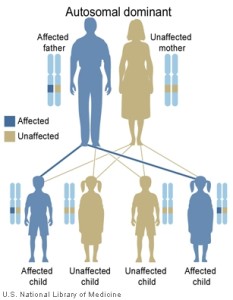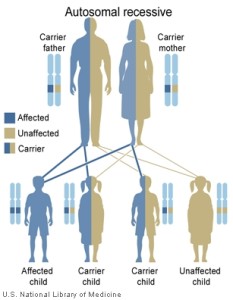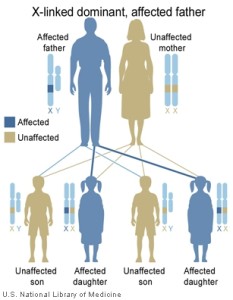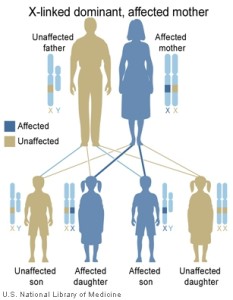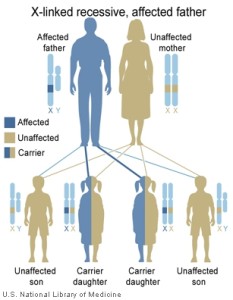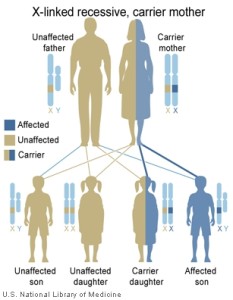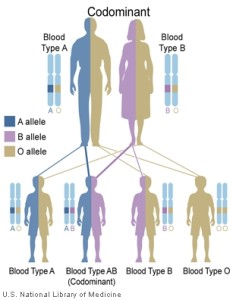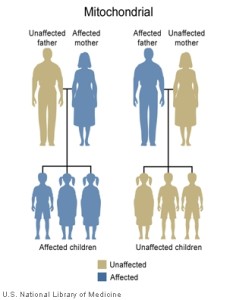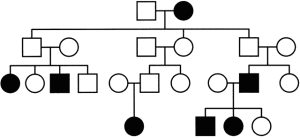A particular disorder might be described as “running in a family” if more than one person in the family has the condition.
A genetic counsellor can use a person’s family history to draw a pedigree (a record of health information about a person’s immediate and extended family) and to help determine whether a disorder has a genetic component.
Some genetic conditions are caused by mutations in a single gene, which is usually inherited in one of several straightforward patterns:
Autosomal Dominant Inheritance:
One mutated copy of the gene is sufficient for a person to be affected with an autosomal dominant disorder. Each affected person usually has one affected parent. Autosomal dominant disorders tend to occur in every generation of an affected family.
In this example, a man with an autosomal dominant disorder has two affected children and two unaffected children. These type of disorders can occur in both male and females and affected individuals have 50% chance of getting the disorder.
Eg diseases
Autosomal Recessive Inheritance:
Both copies of the gene are required to be mutated for a person to exhibit an autosomal recessive disorder. An affected person usually has unaffected parents who each carry a single copy of the mutated gene (and are referred to as carriers). Autosomal recessive disorders are typically seen in consanguineous marriages (i.e., marriage between relatives) or marriages in the close knit community.
Two unaffected parents each carry one copy of a gene mutation for an autosomal recessive disorder. They have one affected child and three unaffected children, two of which carry one copy of the gene mutation. Both males and females are equally affected and there is 25% risk of being affected.
X linked dominant inheritance:
X-linked dominant disorders are caused by mutations in genes on the X chromosome. Both females and males are equally affected and the chance of passing on an X-linked dominant disorder differs between men and women. A mother can pass it on to 50% of both male and female offspring where as father can pass it on only to all his daughters. Families with an X-linked dominant disorder often have both affected males and affected females in each generation. A characteristic of X-linked inheritance is that fathers cannot pass X-linked traits to their sons (no male-to-male transmission).
A).
In this example, a man with an X-linked dominant condition has two affected daughters and two unaffected sons.
B).
In this example, a woman with an X-linked dominant condition has an affected daughter, an affected son, an unaffected daughter, and an unaffected son.
X linked recessive Inheritance:
X-linked recessive disorders are also caused by mutations in genes on the X chromosome. Males are more frequently affected than females, and the chance of passing on the disorder differs between men. Carrier females affects 50% of male offspring where as affected male produces all carrier female offspring. Families with an X-linked recessive disorder often have affected males, but rarely affected females, in each generation. A characteristic of X-linked inheritance is that fathers cannot pass X-linked traits to their sons (no male-to-male transmission).
A)
In this example, a man with an X-linked recessive condition has two unaffected daughters who each carry one copy of the gene mutation, and two unaffected sons who do not have the mutation.
B)
In this example, an unaffected woman carries one copy of a gene mutation for an X-linked recessive disorder. She has an affected son, an unaffected daughter who carries one copy of the mutation, and two unaffected children who do not have the mutation.
Codominance Inheritance:
In this both copies of the gene express and each makes a different protein. As a result there are four types of inheritance. Both males and females contribute equally.
The ABO blood group is a major system for classifying blood types in humans. Blood type AB is inherited in a co-dominant pattern. In this example, a father with blood type A and a mother with blood type B have four children, each with a different blood type: A, AB, B, and O.
Mitochondrial Inheritance:
It is also known as maternal inheritance, as it is concerned with genes present on the mitochondrial DNA which extra chromosomal. Mitochondria are present in the cytoplasm and are therefore contributed only by the mother as the egg and not the sperm contribute mitochondria to the developing embryo. Hence, only females can pass on mitochndrial mutations to their children. Disorders resulting from mutations in mitochondrial DNA can appear in every generation of a family and can affect both males and females, but fathers do not pass these disorders to their children.
In one family, a woman with a disorder caused by a mutation in mitochondrial DNA and her unaffected husband has only affected children. In another family, a man with a condition resulting from a mutation in mitochondrial DNA and his unaffected wife has no affected children.
Complex disease Inheritance:
Many other disorders are caused by a combination of the effects of multiple genes or by interactions between genes and the environment. Such disorders are more difficult to analyze genetically, and they do not follow the patterns of inheritance described above. These include heart disease, diabetes, schizophrenia, asthma and certain types of cancer.

